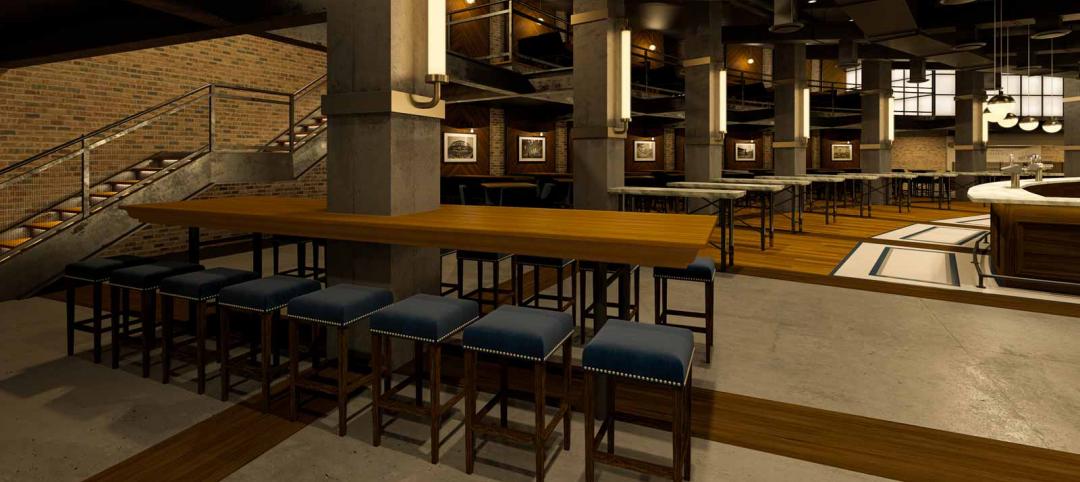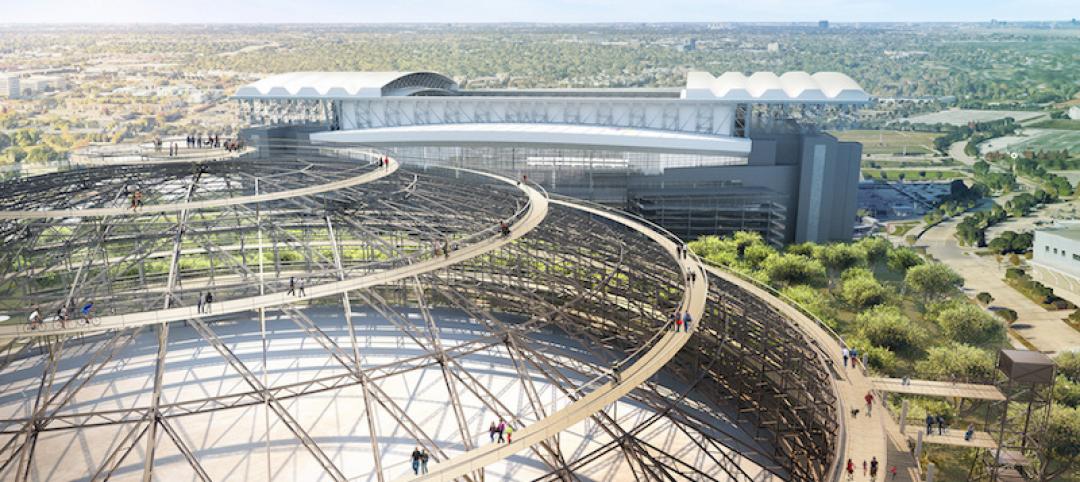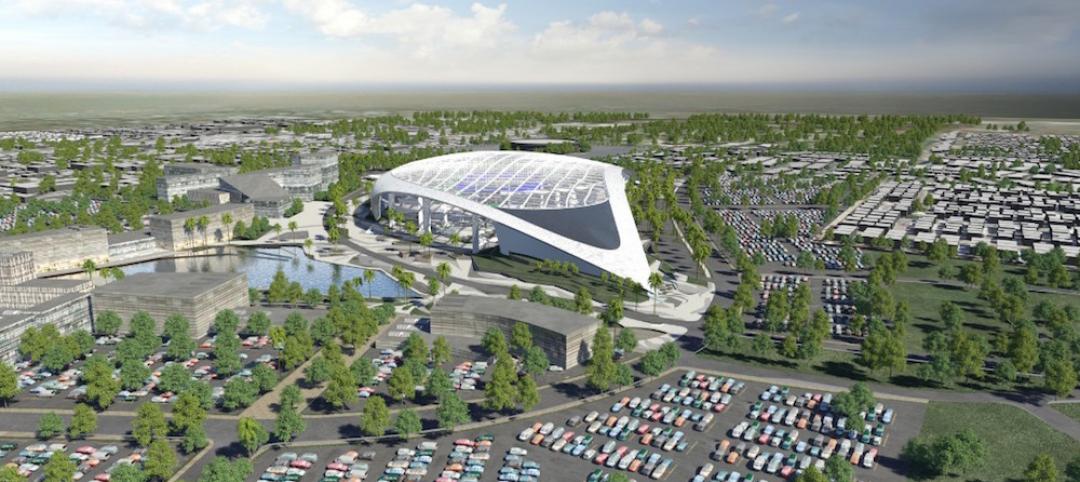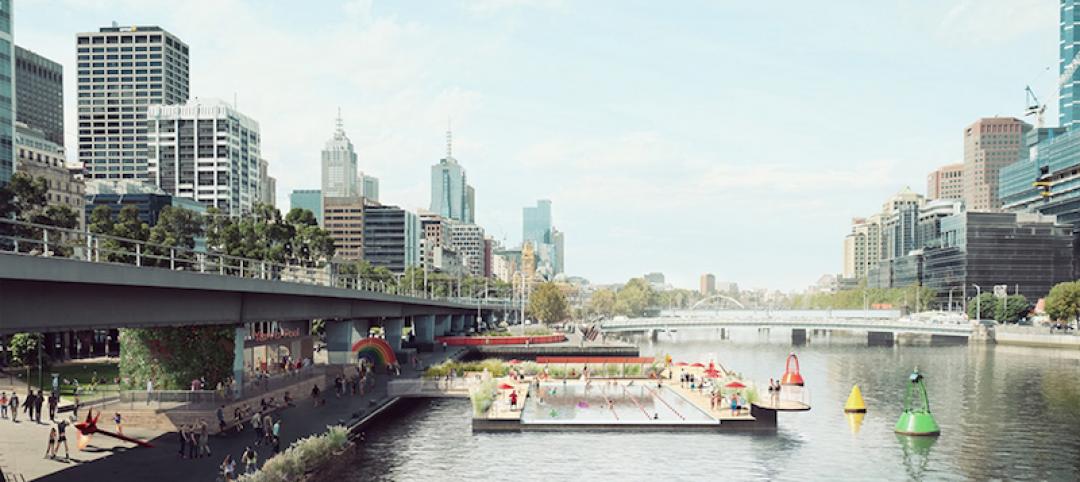As the U.S. Open Grand Slam tennis tournament in New York moves into its second week, the massive retractable roof over the 23,711-seat Arthur Ashe stadium has been drawing oohs and aahs from players and fans alike.
The $150 million roof addition is part of a $550 million renovation of the Billie Jean King National Tennis Center in Flushing, Queens. The roof itself was five years in the making, and posed several structural and engineering challenges to the Building Team, which included the architect Rossetti, the engineering firm WSP | Parsons Brinckerhoff, and the general contractor Hunt Construction Group.
This morning, BD+C interviewed WSP | Parsons Brinckerhoff execs Ahmad Rahimian, P.E., SE, F.ASCE, director of Building Structures; and Yoram Eilon, P.E., Senior Vice President of Building Structures, about this project.
Rahimian noted that any stadium construction or renovation is complicated. This one, though, was unique in several ways. For one thing, there was no precedent to draw upon in the tennis world, as Arthur Ashe is by far the largest stadium on the tour. And that facility, which opened in August 1977, wasn’t designed to include a roof.
Rahimian said that the U.S. Tennis Association (USTA), which owns and operates the venue and annual event, actually started thinking about a roof three years after the stadium opened. Those plans became more urgent in 2008, when rain interfered with the completion of some matches. Since then, rain has been a perennial threat, and occasional impediment, to the tournament’s scheduling. Design discussions for a roof began around 2011, he said.
Given the stadium’s age and structural condition, the Building Team concluded that the best solution would be to build a freestanding structure for the retractable roof that doesn’t touch the stadium itself. (There’s a 15-inch gap between the stadium and the roof pavilion.)
That roof structure sits on eight super-steel columns and 16 great brace angles that rise 125 feet above ground level, and support an 80-foot-high Teflon-covered membrane and two 500-ton panels that move back and forth over a 62,500-sf opening.
The retractable panels move on wheel assemblies mounted on rails, and can be opened or closed by cables and winches in only seven minutes.
The National Tennis Center is located in a marshy part of Queens, so the Building Team had to find answers to soil issues in order to support a roof pavilion that would weigh 6,500 tons. The steel columns are organized in an octagonal pattern that corresponds to the shape of the stadium. Each column is mounted on a concrete pier that spreads the weight load of the pavilion onto an underground concrete slab. That platform is supported by pilings that go as deeply as 180 feet into the ground.
Eilon noted, though, that this wasn’t a simple drilling job, as there are massive amounts of utilities infrastructure underground that needed to be circumvented or rerouted, not to mention the subway and Long Island Railroad systems nearby.
In addition, construction shut down during the two weeks of the tournament, which meant that cranes had to be taken down or relocated.
(Despite New York’s reputation for being a difficult place to get construction done, Rahimiam and Eilon said the city wasn’t at all intrusive. “I think they understood the significance of this to the city,” says Eilon.)
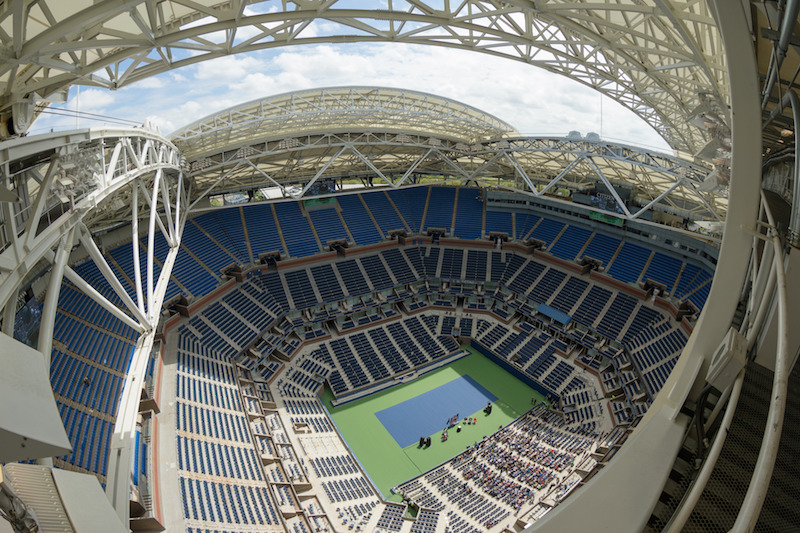
Even when the roof is open, 60% of the stadium's 23,771 seats are shaded. Image: USTA/Jennifer Pottheiser
Even when the roof is open, at least 60% of the stadium seats are shaded. To mitigate condensation and to ventilate the stadium when the roof is closed, the Building Team installed 16 air diffusers along a six-foot-wide duct that encompasses the top of the stadium, the WSP execs confirmed. As cooled air drops into the bowl of the stadium, it’s expelled by mechanical fans.
Rahimian and Eilon say that despite all this HVAC equipment, the stadium is relatively quiet when the roof is closed, although that enclosure does tends the magnify ambient sounds from the audience, which at the U.S. Open are pretty noticeable to begin with.
USTA had budgeted about $100 million for the roof project, but dealing with structural support, condensation, and ventilation tacked on another $50 million to the price tag, says Rahimian.
WSP | Parsons Brinckerhoff is involved in other facets of the National Tennis Center’s renovation, which will include an expanded Grandstand stadium. Whether other sports stadiums embrace retractable roofs, though, remains to be seen. Roland Garros, the location of the French Open in Paris, intends to install a retractable roof to cover its Court Philippe Chatrier, although construction has been pushed back to 2020 at the earliest, according to Tennis Magazine.
Rahimian believes retractable roofs help venues to “justify” their brands, and he expects more projects like these in the future. “I think it’s a trend.”
Related Stories
Sports and Recreational Facilities | Jul 20, 2016
Chicago Cubs unveil plans for premier fan club underneath box seats at Wrigley Field
As part of the baseball team’s larger stadium renovation project, the club will offer exclusive food, drinks, and seating.
Events Facilities | Jul 19, 2016
Houston architect offers novel idea for Astrodome renovation
Current plans for the Astrodome’s renovation turn the site into an indoor park and events space, but a Houston architect is questioning if that is the best use of the space
Sports and Recreational Facilities | Jul 18, 2016
Turner and AECOM will build the Los Angeles Rams’ new multi-billion dollar stadium project
The 70,000-seat stadium will be ready by the 2019 NFL season. The surrounding mixed-use development includes space for retail, hotels, and public parks.
Building Tech | Jul 14, 2016
Delegates attending political conventions shouldn’t need to ask ‘Can you hear me now?’
Each venue is equipped with DAS technology that extends the building’s wireless coverage.
Contractors | Jul 4, 2016
A new report links infrastructure investment to commercial real estate expansion
Competitiveness and economic development are at stake for cities, says Transwestern.
Sports and Recreational Facilities | Jun 9, 2016
Swimming may be returning to Melbourne’s polluted Yarra River… kind of
The addition of a pool to the Yarra may help improve people’s perception of the river and act as the impetus to an increase in support for improving its water quality.
Building Team Awards | May 23, 2016
'Greenest ballpark' proves a winner for St. Paul Saints
Solar arrays, a public art courtyard, and a picnic-friendly “park within a park" make the 7,210-seat CHS Field the first ballpark to meet Minnesota sustainable building standards.
Sports and Recreational Facilities | May 20, 2016
Texas Rangers announce plans for $1 billion retractable roof ballpark
The new stadium will replace Globe Life Park, which is only 22 years old.
Sports and Recreational Facilities | May 19, 2016
Audacy brings wireless lighting controls to Wrigley Field’s new clubhouse
The Audacy system uses a combination of motion sensors, luminaire controllers, light sensors, and switches that are all connected and coordinated by Gateways.
Sports and Recreational Facilities | May 6, 2016
NBA’s Atlanta Hawks to build new practice center with attached medical facilities
The team will have easy access to an MRI machine, 3D motion capture equipment, and in-ground hydrotherapy.



